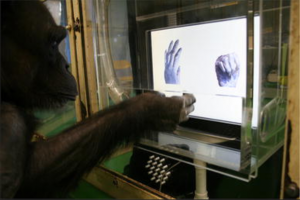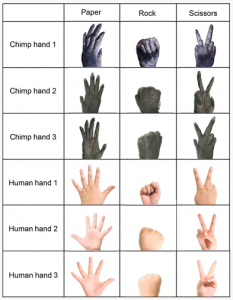Chimps Understand Rock-Paper-Scissors as Well as Preschoolers
Posted on Categories Discover Magazine

Rock smashes scissors. Scissors cut paper. Paper covers rock. The rules behind the favorite game of schoolyard kids and adults deciding who takes out the trash are pretty simple. But they also represent a kind of logic problem. Four-year-olds can learn the rules, and so can chimpanzees—but the differences in how kids and apes become proficient reveal a little about how their minds work.
The relationship between the three items in rock-paper-scissors is circular. There isn’t a straightforward hierarchy among them. Animals in the wild can benefit from understanding linear hierarchies, such as the order of dominance in a group, or who can fit inside whose mouth. But earlier studies have shown that some animals, such as monkeys, rats and pigeons, can also learn circular relationships.
At the Primate Research Institute at Kyoto University in Japan, scientists attempted to teach seven adult chimpanzees the basics of rock-paper-scissors. In daily training sessions, the apes sat in front of a touch screen and looked at pictures of chimp hands making “rock,” “paper” or “scissors” gestures. First the apes saw only paper paired with rock; they were rewarded with a bite of apple each time they selected paper, but heard a buzzer if they touched rock. Once the apes had mastered that task, they started seeing a new pair of images: rock and scissors. Again, they were rewarded if they chose the right answer.
Next they saw the third pair of images: scissors and paper. This is the relationship that completes the circle, and it took the chimps a lot longer to get the knack of it. Two animals never learned the task at all. The other five, when they’d finally grasped the rules of the game, were tested on photos of other hands in random pairings.
The researchers used a similar process to teach rock-paper-scissors to 38 kids in China, ranging from almost 3 years old to almost 6. Instead of apple chunks, the kids got to see a cute picture of baby chimpanzees when they chose the right answer. As a reward for participating in the experiments, they got stickers.
After the kids had learned the rules, they were also tested on random pairs of hands. Kids older than about 50 months performed better than they would have by guessing. In other words, children of about 4 can grasp the rules of rock-paper-scissors as well as a chimpanzee.
But the learning process didn’t look the same for human and non-human apes. Chimps found it challenging to learn the third relationship—the one that completes the circle—while it didn’t give kids any extra trouble. And when kids got the wrong answer in a training session, like picking rock over paper, they switched answers right away. Chimps needed more tries to correct themselves. The authors think this might be because children can control their impulses better than chimps. (If there’d been candy on the line, though, it might have been a different story.)
Images: from Gao et al.
